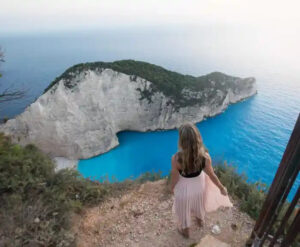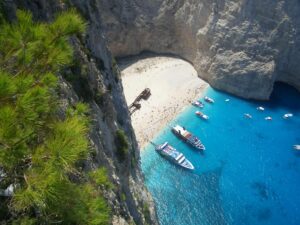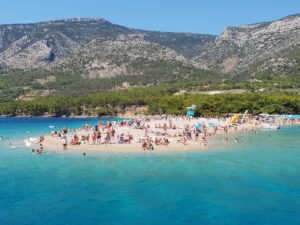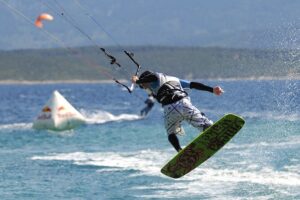Beach
Navagio
Navagio, Greece
Navagio Beach (aka Shipwreck Cove) on the Greek Island of Zakynthos is arguably one of the most beautiful beaches in the world! Here’s how to see shipwreck beach for yourself.
The island of Zakynthos off the southwest coast of Greece is one of the country’s quieter islands. However it has one particularly incredible highlight called Navagio Beach (also known as Shipwreck Beach). A sandy little cove surrounded by towering limestone cliffs — plus the rusting remains of an old shipwreck.
This stunning Greek beach surrounded by brilliant blue ocean water is an Instagram favorite, and many travelers include Zakynthos on their itinerary specifically to visit this amazing beach in Greece.
We spent 3-days exploring Zakynthos with a rental car, including a few trips to Shipwreck Beach, and wanted to put together a little guide for you.
Where Is Shipwreck Beach?
Shipwreck Beach, known locally as Navagio Beach, is located on the North West corner of Zakynthos Island. The island is about 250 km west of Athens in the Ionian Sea.
To reach Zakynthos, you can fly directly from Athens or take a ferry from Kyllini on the mainland. Ferries to Zakynthos run 7 times per day between 5:30am and 10:30pm and cost about €10 per person each way, or €35 if you’re taking a car.
Cliff Top Viewpoints
 The most popular postcard photos of Shipwreck Beach come from the top of the 200 meter (650 ft) tall cliffs that overlook it, rather than on the beach itself. While the beach is awesome to visit in person, the views from the cliffs are much more spectacular.
The most popular postcard photos of Shipwreck Beach come from the top of the 200 meter (650 ft) tall cliffs that overlook it, rather than on the beach itself. While the beach is awesome to visit in person, the views from the cliffs are much more spectacular.
However keep in mind that Navagio beach is located on another side of the island from the capital city of Zakynthos (same name as the island). So the best way to get out there is to either rent a car, like we did, or find a tour company that will take you out there in a van. It’s also possible to hire a taxi from the capital, but it will cost around €100 EURO round trip.
The drive from Zakynthos town out to Navagio Beach takes about 45 minutes. Once there, you’ll head down an entrance road to the parking area, where there are a few stalls selling food, ice cream, drinks, and souvenirs. Parking is free.
The Viewing Platform
There is an official viewing platform located right below the parking area. It’s safe, secure, and there’s usually a long line to get a photo.
However the photos you get from this platform are not that great! You don’t get a full view of the whole beach. Tourism officials really need to improve this platform if they want to avoid people from walking out on the side trail… where the view is much better. The Cliff Walk
To reach the best place to get photos of Shipwreck Beach, you need to go for a little hike. Beside the viewing platform (to the right) there is a fenced off area, with a single entrance (and plenty of warning signs).
Walking out this way, you’ll find a rough path that leads away from the parking lot and tourist shops. The path is not really maintained, and probably isn’t safe for older people or super little kids. It’s a long walk over jagged rocks, in the hot sun, with no benches or shade nearby.
The best time of day for photos of the beach is around noon, when the sun is directly overhead (and the cliffs aren’t casting a shadow). Sunset is also a wonderful time to visit.
Visiting The Beach By Boat
 To actually step foot on the beautiful secluded Greek beach at Shipwreck Cove, there’s only one way. By boat. There are multiple tour companies that offer affordable boat trips to this most famous beach in Greece.
To actually step foot on the beautiful secluded Greek beach at Shipwreck Cove, there’s only one way. By boat. There are multiple tour companies that offer affordable boat trips to this most famous beach in Greece.
Some of these boats leave from the nearby town of Agios Nikolaos (where you can even rent and captain your own boat, if you have experience), but others start directly in Zakynthos Town.
During the boat trip to Navagio Beach (Shipwreck Cove), you’ll also visit other beautiful places off the Zakynthos coast, like the Blue Caves and Xygia Sulfur Beach.
Keep in mind that Shipwreck Beach is the most popular tourist attraction on the island, so the beach gets pretty packed. And you won’t actually get to spend too much time on the beach itself (about 20 minutes), as they shuttle tourists in and out throughout the day.
To visit the beach with the fewest number of people, or to stay as long as possible, take the earliest tour you can — or even better, rent a private boat.
Praia
Praia as Catedrais, Spain
As Catedrais beach is located on Spain’s northern coast in Galicia near Ribadeo and is only a 20-minute drive from the city. It is known all over the world as the Beach of the Cathedrals (As Catedrais Beach) or the Beach of Holy Waters (Praia de Augas Santas). These names are a result of the giant rock formations that resemble the flying buttresses found in cathedrals. On windy days and during low tide, you can hear the wind whistling through the large stones, resembling organ music that is played in a church. This beach is absolutely unique in its natural formations. When the water recedes, you can see caves, rocks and stone arches that truly magnify nature.
The arches reach 90 feet in height, while deep, eroded caves stretch back into the cliffside. There are also sandy corridors through which you can walk to other beaches. However, you must be careful and turn back in time before the tides begin to rise and cover the coast again.
It can be quite unexpected! During high tide, you can still visit the beach and enjoy the views from the cliffs. This place is an incredible spot for those who love peace and harmony with nature. When you plan your visit to Spain, be sure to take the opportunity to visit one of the most beautiful beaches in the world!
The most popular visiting season is summer. During this time the beach is overcrowded, and from July to September, the access is restricted. The best time is October to June as the visitors may have a more fulfilling experience without the crowds. Another popular time is Easter.As to the tide, it rises and lowers twice a day, and timing varies. So you will have to check the tide tables before you go.
Zlatni Rat
Zlatni rat beach in Croatia is one of the most beautiful beaches in the Mediterranean, and thanks to its particular shape, it is also one of the most exceptional beaches in the world. Many world-famous business and travel magazines like the New York Times, National Geographic, the Insider Travel listed it many times in their articles as one of the most spectacular beaches in the world.
Zlatni rat’s elegance and appeal have made it the symbol of both the town of Bol and Croatia, and the government of Croatia protects it as a geomorphological monument. But it is not just its shape that makes it beautiful and unique. It is surrounded by the crystal clear sea that goes from turquoise blue to dark blue in just 10 to 20 meters, and it is bordered by decades-old pine trees planted by the locals to create some natural shade.
The beach is situated less than 2 km from the town of Bol, connected with a lovely promenade under the pine tree’s shade, along which you can find many other small beaches.
This fascinating 500 meters long pebble beach has a unique shape, like a small peninsula that stretches into the sea with almost 900 meters of beach sea line on both sides. The area of the beach is over 20.000 square meters and can comfortably accommodate over 10.000 people.
The curiosity about this beach is that it changes its shape and position depending on the wind, tide, and the current, and sometimes, the tip of the beach rotates so significantly that it forms a small pool. Usually, the mornings are windless, and the wind blows every afternoon, but one side of the beach always has calm water and offers perfect conditions for families with small children.
Interesting facts about Zlatni rat beach
First, let me tell you that many people ask if the Zlatni rat is a natural or man-made beach; it is a natural phenomenon and is solely built by nature without any human intervention.
 Most people make one mistake when imagining the beach: it is a sandy beach, well, it is not a sandy beach. Zlatni rat beach is a pebble beach; pebbles are small fine round stones that are nice to walk on. They are great to lay onto since they shape under you anatomically as the perfect mattress. The size of the pebbles is getting smaller as you reach the sea line.
Most people make one mistake when imagining the beach: it is a sandy beach, well, it is not a sandy beach. Zlatni rat beach is a pebble beach; pebbles are small fine round stones that are nice to walk on. They are great to lay onto since they shape under you anatomically as the perfect mattress. The size of the pebbles is getting smaller as you reach the sea line.
Apart from its top moving and shifting from one side to the other, there are a few other interesting facts about Zlatni rat beach. When the top is turning, there are times when it forms a lake on top of the beach as its point turns all the way to touch the beach back. Until the 1950s, the area that is now covered with pine trees used to be a vineyard. Only in 1950 did the government take possession of the land, and Bol municipality planted pine trees there.
Another interesting fact is that Zlatni rat beach is growing; it is getting longer over the years. The latest data shows that from 2006 until this year, Zlatni rat beach grew in length by roughly 80 meters. The Eastside was measured this year at 500 meters (420 meters in 2006.), the west side measured 468 meters (360 meters in 2006.), and the centre from the last tree to the top of the Zlatni rat was measured at 197 meters (158 meters in 2006.).
What to do on Zlatni rat beach
Zlatni rat beach is famous among adrenaline junkies and those who love windsurfing and kitesurfing. The strong thermic wind called “Maestral” regularly blows during nice weather, giving experienced windsurfers and kitesurfers the adrenaline they need. Nearby the beach, there are several windsurfing and kitesurfing centres where you can take lessons and rent the equipment.
 But the beach also offers plenty of other exciting things to do for young children and adults like beach volley, parachute rides that give you a fantastic bird’s eye view of the beach, jet ski, banana boat rides, and an enormous water park, etc. Near Zlatni rat you can also go scuba diving, play tennis or volleyball on the Borak beach. You can rent rental motorboats and explore many other secluded beaches west and east of Bol.
But the beach also offers plenty of other exciting things to do for young children and adults like beach volley, parachute rides that give you a fantastic bird’s eye view of the beach, jet ski, banana boat rides, and an enormous water park, etc. Near Zlatni rat you can also go scuba diving, play tennis or volleyball on the Borak beach. You can rent rental motorboats and explore many other secluded beaches west and east of Bol.
On Zlatni rat beach, you can rent paddle boats with slides or kayaks to explore the coastline. There are two restaurants just a few steps from the beach, where you can enjoy local specialities under the natural shade, and several stands where you can buy fresh fruit, smoothies, pancakes, etc.
Two curiosities to mention for all planning a visit to Zlatni rat, the first one – don’t forget to visit the remnants of an ancient Roman Villa Rustica, hidden among the pine trees just a few meters from the beach. The second is to see how lucky you are and find a “stone of happiness.” It is a small stone that closes the seashell, looks like a snail fossil, and brings luck to its finder. You can probably find them on the whole beach, but the best place to search for them is on the west side beginning of the beach.
We cannot forget that Zlatni rat beach has the “Blue Flag,” so be sure that you will find all the comforts you need, but most of all, a clean beach and clean waters, so help us keep it that way.
Getting from Bol to Zlatni rat beach
What is the Zlatni rat beach location? Zlatni rat is located 2km west of the Bol centre. To get to Zlatni rat, you can choose one of four options. The least recommended way is by car since Bol is a tiny town and driving a car in the summer months is not a pleasure. However, if you choose to go there by car, there is ample parking for you to leave your vehicle there for the day (cost is 70 kuna ~ 9 EUR).
An excellent option is to walk from Bol to Zlatni rat beach by the sea, there is a beautiful promenade (walkway) in the shade of pine trees, and the walking from Bol is roughly 20-30 minutes easy and relaxed walking speed.
Your third option is a street tourist train, that rides all day back and forth from Bol centre (near petrol station) and costs roughly 2,5 EUR one way.
The fourth exciting option is taxi boats that go all day from Bol centre straight to Zlatni rat beach. These are small taxi boats that carry from 20 to 50 people. The ride is fun along the coast and takes 10-15 minutes. It also costs roughly 2,5 EUR one way.
Lara, Cyprus
Lara, Cyprus
This stunning unspoilt beach has clean, calm water and pristine sands for those who want to escape people and parasols. The beach is most famous, however, for being home to a turtle hatchery; this is one of the world’s few remaining havens for green and logger-head turtles to nest. Volunteers monitor the female turtles and around June and July collect their eggs to place in the hatchery, to protect them from predators and inquisitive tots. Monk seals also dwell in the sea caves around the peninsula.
Note that the beach has been a protected area since 1971 and no sun loungers are permitted. Likewise, private vehicles are banned from coming to the beach during the egg-laying season; at other times you can approach, although the path is a dirt track. If you feel uneasy go for a 4WD rental vehicle or take a tour. Look for the signs to Lara Restaurant at the adjacent Lara Bay, where you can stop for a drink or snack on the vast terrace overlooking the beach.
- ←
-
Email Us
Please send us an Email
